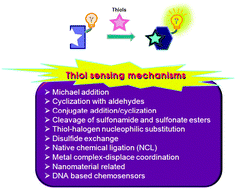Recent progress in luminescent and colorimetric chemosensors for detection of thiols
Abstract
In the past few decades, the development of optical probes for

* Corresponding authors
a
Department of Chemistry, Korea University, Seoul 130-701, Korea
E-mail:
jongskim@korea.ac.kr
Fax: +82-2-3290-3121
Tel: +82-2-3290-3143
b
Department of Chemistry and Nano Science and Department of Bioinspired Science (WCU), Ewha Womans University, Seoul 120-750, Korea
E-mail:
jyoon@ewha.ac.kr
Fax: +82-2-3277-2384
Tel: +82-2-3277-2400
c State Key Laboratory of Materials-Oriented Chemical Engineering, College of Chemistry and Chemical Engineering, Nanjing University of Technology, Nanjing 210009, China
In the past few decades, the development of optical probes for

 Please wait while we load your content...
Something went wrong. Try again?
Please wait while we load your content...
Something went wrong. Try again?
H. S. Jung, X. Chen, J. S. Kim and J. Yoon, Chem. Soc. Rev., 2013, 42, 6019 DOI: 10.1039/C3CS60024F
To request permission to reproduce material from this article, please go to the Copyright Clearance Center request page.
If you are an author contributing to an RSC publication, you do not need to request permission provided correct acknowledgement is given.
If you are the author of this article, you do not need to request permission to reproduce figures and diagrams provided correct acknowledgement is given. If you want to reproduce the whole article in a third-party publication (excluding your thesis/dissertation for which permission is not required) please go to the Copyright Clearance Center request page.
Read more about how to correctly acknowledge RSC content.
 Fetching data from CrossRef.
Fetching data from CrossRef.
This may take some time to load.
Loading related content
